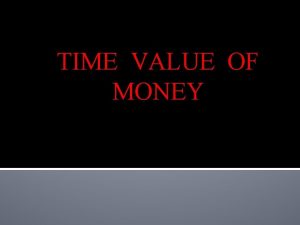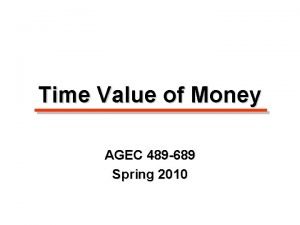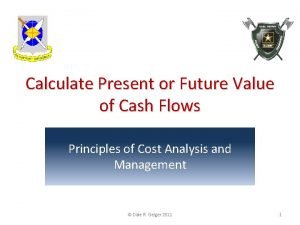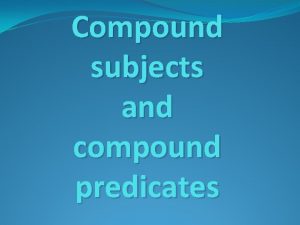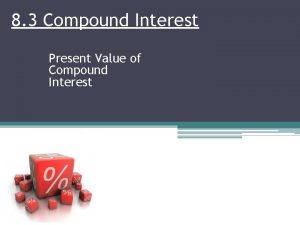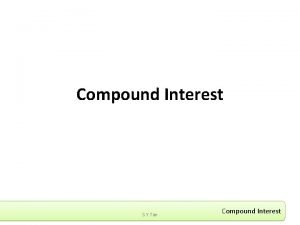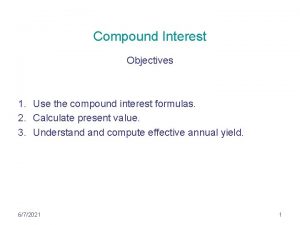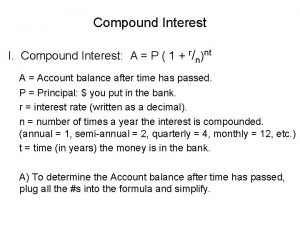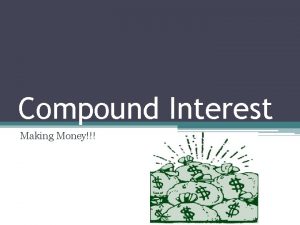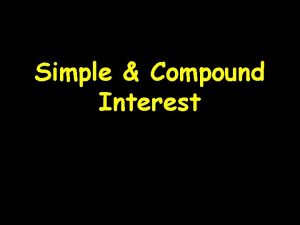Compound Interest Future Value Definitions Compound interest Interest












- Slides: 12

Compound Interest: Future Value

Definitions �Compound interest: Interest that is added to the principal before new interest earned is calculated. So interest is calculated on the principal and on interest already earned �Compounding period: The intervals at which interest is calculated �Future value: The total amount of an investment after a certain length of time

Mena invests $2000 in a bank account that pays 6%/a compounded annually. The savings account is called the “ Accumulator” and pays compound interest. Let’s determine what her balance will be at the end of five years. Year Balance at start of year Interest earned Balance at end of year 0 - - $2000. 00 1 $2000. 00 $120. 00 $2120. 00 2 $2120. 00 $127. 20 $2247. 20 3 $2247. 20 $138. 83 $2382. 03 4 $2382. 03 $142. 92 $2524. 95 5 $2524. 95 $151. 50 $2676. 45 At the end of five years, Mena’s balance will be $2676. 45.

Now let us compare the total amount of Mena’s investment with that based on the same principal earning simple interest, as opposed to compound interest, which we have just calculated. Year Balance at start of year Interest earned Balance at end of year 0 - - $2000. 00 1 $2000. 00 $120. 00 $2120. 00 2 $2120. 00 $2240. 00 3 $2240. 00 $120. 00 $2360. 00 4 $2360. 00 $120. 00 $2480. 00 5 $2480. 00 $120. 00 $2600. 00 After five years of accumulative compound interest, Mena’s new balance became $2676. 45. After five years of simple interest, Mena’s balance became $2600. Therefore, earning compounded interest, Mena would gain $76. 45 more than if she earned simple interest. The advantage of earning compound interest over simple interest is that you earn more.

Tim borrows $5300 at 4. 6%/a compounded annually. a) How much will he have to pay back if he borrows the money for 10 years? b)Determine the future value, A, and interest earned , I, if he invested a Principal of $P for n years at i%/a compounded annually. a) tn= P(1+r)n = 5300(1+0. 046)10 = 5300(1. 5679) = $8309. 84 Tim would have to pay back $8309. 84 after 10 years. b) Future value: A = P(1+i)n Total interest earned: I = P[(1+i)n-1]

Lara’s grandparents invested $5000 at 4. 8%/a compounded quarterly when she was born. How much will the investment be worth on her 21 st birthday? P = 5000 I = i/4 = 0. 048/4 compounded quarterly = 0. 012 n = 4 x yrs. = 4 x 21 compounding periods = 84 A = P(1+i)n A = 5000(1+0. 012)84 = $13 618. 62 The investment will be worth $13 618. 62 on Lara’s 21 st birthday.

Nicolas invests $1000. How long would it take for his investment to double for each type of interest earned? a) 5%/a simple interest a) P = 1000 r = 5% = 0. 05 i = $1000 I = Prt 1000 = 1000(0. 05)t 1000 = ( 1000(0. 05))t 1000(0. 05) t = 20 It would take 20 years for Nicholas’ investment to double when earning 5%/a simple interest.

Nicolas invests $1000. How long would it take for his investment to double for each type of interest earned? b) 5%/a compounded semi-annually b) i = 0. 05 = 0. 025 2 A = P(1+i)n Solve by guess-and-check A = 1000(1+0. 025)40 A = 2685. 06 too high A = 1000(1+0. 025)20 A = 1638. 62 too low A = 1000(1+0. 025)28 A = 1996. 50 close to double n = 28 = 2(semi-annually) x 14(yrs. ) It would take 14 years for Nicholas’ investment to double when earning 5%/a compounded semi-annually.

Key Ideas �Compound interest is calculated by applying the interest rate to the principal and any interest already earned �The total amounts at the end of each interest period form a geometric sequence. So compound interest results in exponential growth �The total amount, A, of an investment after a certain period is called the future value of the investment

Need to Know �Banks pay or charge compound interest at regular intervals called the compounding period. If interest is compounded annually, then at the end of the first year, interest is calculated and added to the principal. At the end of the second year, interest is calculated on the new balance (principal plus interest earned from the previous year). This pattern continues every year the investment is kept

Need to know(con’t) �The future value of an investment earnings compound interest can be calculated using formula A = P(1+i)n, where A is the future value; P is the principal; I is the interest rate per compounding period, expressed as a decimal; and n is the number of compounding periods

Need to know(con’t) � The most common compounding periods are: Annually 1 times per year I = annual interest rate /1 N= number of years x 1 Semi-annually 2 times per year I = annual interest rate /2 N= number of years x 2 Quarterly 4 times per year I = annual interest rate /4 N= number of years x 4 Monthly 12 times per year I = annual interest rate /12 N= number of years x 12 � Compound interest can be calculated using formula I = A-P or I = P[(1+i)n -1], where I is the total interest
 تفاوت future perfect و future continuous
تفاوت future perfect و future continuous Future perfect simple continuous
Future perfect simple continuous Rumus fvifa
Rumus fvifa Pv table
Pv table Present value vs future value
Present value vs future value Compound interest meaning
Compound interest meaning Penciptaan nilai adalah
Penciptaan nilai adalah Future vs future perfect
Future vs future perfect Simple present tense simple past tense simple future tense
Simple present tense simple past tense simple future tense Future continuous.
Future continuous. Future nurse programme
Future nurse programme Future tense
Future tense Plan present continuous tense
Plan present continuous tense


